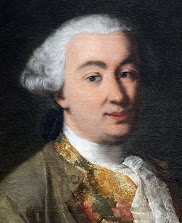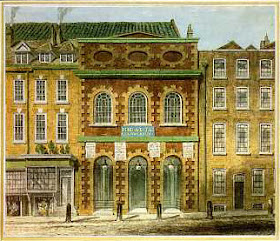Musician from Burano had a talent for comic opera
The prolific Venetian composer Baldassare Galuppi, who worked alongside the playwright Carlo Goldoni, died on this day in 1785 in Venice.Galuppi became a major figure
in the evolution of comic opera
At the height of his career, Galuppi achieved international success, working at different times in Vienna, London and Saint Petersburg, but his main base was Venice, where he held a succession of prestigious posts during his life.
Galuppi was born on the island of Burano in the Venetian lagoon and was sometimes referred to as Il Buranello, a signature he used on his music manuscripts. His father was a barber who also played the violin in an orchestra, and is believed to have been his first music teacher.
At the age of 15, Galuppi wrote his first opera, which was performed at Chioggia and Vicenza. He then became harpsichordist at the Teatro della Pergola in Florence.
In the early part of his career, Galuppi was successful in the opera seria genre, but after 1749 many of his operas were comic collaborations with the Venetian dramatist Carlo Goldoni. The most popular of his comic operas was his 1754 composition Il filosofo di campagna – The Country Philosopher.
He was one of the earliest opera composers to use the ensemble finale, in which all the characters appear together in a musical ensemble that carries the action forward to the end of the act. He was regarded as the father of comic opera - opera buffa - by the next generation of composers.
 |
| Carlo Goldoni, with whom Galuppi worked successfully |
Galuppi belonged to a group of composers, including Johann Adolph Hasse, Giovanni Battista Sammartini and C P E Bach, whose works all displayed a style of music that developed in Europe after the late Baroque era.
The composer held important positions with charitable and religious organisations in Venice and for these posts he composed a lot of sacred music. His most prestigious appointment was as maestro di cappella at the Doge’s chapel in St Mark’s Basilica. He was also a virtuoso performer and composer of music for keyboard instruments.
In 1741, Galuppi was invited to work in London, where he spent 18 months supervising productions for the Italian opera company at the King’s Theatre. At least four of the operas the company performed had been composed by Galuppi.
On his return to Venice, Galuppi continued to compose for the opera houses, often in partnership with the librettist Pietro Metastasio. He wrote his first comic opera, La forza d’amore in 1745.
He was invited to the court of Maria Theresa in Vienna in 1748, where he composed the music for Metastasio’s libretto Artaserse. He compressed four arias at the end of the first act into a single dramatic ensemble piece, which was seen as a breakthrough that strengthened the relationship of the music to the drama, although Metastasio was reported to have been unimpressed.
 |
| The King's Theatre in London's Haymarket, where Galuppi worked for 18 months |
In 1794, he was summoned to be court composer to Catherine the Great to Saint Petersburg, where he composed both operas and sacred music and gave harpsichord recitals.
On his return to Venice, he continued to be a prolific composer of both operas and sacred music. His last opera was La serva per amore which premiered in October 1773. In 1782, he conducted concerts to mark the visit to Venice of Pope Pius VI. His last known completed work was the 1784 Christmas mass for St Mark’s.
After Galuppi’s death, his body was buried in the church of San Vitale. The actors from the Teatro San Benedetto sang in a requiem mass for him at the church of Santo Stefano, which was paid for by local professional musicians.
Napoleon’s invasion of Venice in 1795 resulted in Galuppi’s manuscripts being either destroyed, lost or scattered around Europe.
Robert Browning wrote a poem, A Toccata of Galuppi’s, about the composer and his work, but it was not until the end of the 20th century that Galuppi’s compositions were revived in live performances and recordings.
Travel tip:The statue of Galuppi
in Piazza Galuppi
Burano, where Baldassare Galuppi was born, is an island at the northern end of the Venetian lagoon and is known for its lace work and brightly coloured fishermen’s houses. More than 2,700 people live there and virtually all of the island has been built on, with very little green space. The island can be reached in about 45 minutes from St Mark’s Square in Venice by vaporetto. There is a statue of Galuppi in Piazza Galuppi, the main square. Burano’s church of San Martino has a leaning campanile and a painting of the Crucifixion by Giambattista Tiepolo.
Travel tip:
Baldassare Galuppi was buried in the former church of San Vitale (known as San Vidal) in Venice, although there is no gravestone for the composer there. The church has a 29 metre (94 feet) bell tower, or campanile, which was part of the original 1084 design, although it was rebuilt along with the church after a fire in 1105. The church is at one end of the Campo Santo Stefano and is now used as an event and concert hall.
Also on this day:
106BC: The birth of Cicero, Roman politician and philosopher
1698: The birth of poet and librettist Pietro Metastasio
1920: The birth of singer-songwriter Renato Carosone
1929: The birth of film director Sergio Leone
1952: The birth of politician Gianfranco Fini

































